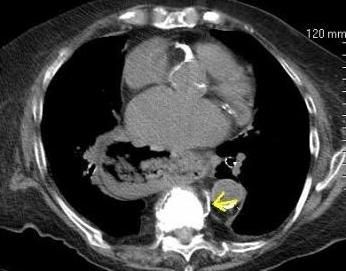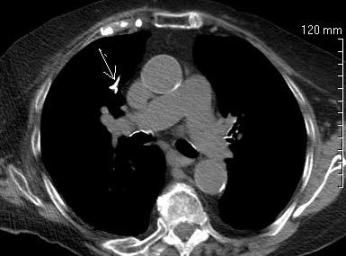Complications Following Treatment of Osteoporotic Vertebral Fracture

An 88-year-old woman who underwent elective balloon kyphoplasty (BKP) of thoracic vertebrae T8 and T9 for a compression fracture and resulting pain was sent to the hospital from rehabilitation on postoperative day 15 with persistent sharp right chest pain of 10 days’ duration and right shoulder pain. Her medical history included coronary artery disease, atrial fibrillation, and rheumatoid arthritis, and a remote history of right cephalic vein deep venous thrombosis and pulmonary embolism. She was taking oral anticoagulation (warfarin) and prednisone. She was hemodynamically stable, in no acute distress.
There was some reproducing tenderness at right 4th to 6th costochondral joints. The patient also had reduced range of motion of the right shoulder, with severe pain on external rotation. Neurologic examination revealed a new left foot drop with reduced muscle power (2/5) in all muscle groups in the left leg and 4/5 muscle power in the right leg. Tenderness was noted on the thoracic spine from T8 to T11. A radiograph of the chest revealed a high-density opacity on the right suprahilar surface. A follow-up CT scan of the chest without intravenous contrast found extravasated acrylic cement contiguous to the vertebral body and extending into the venous structure (Figure 1, above); there was also a linear focus of very high density in an artery in the right upper lobe (Figure 2, below), consistent with embolic cement.
The patient’s INR was 1.6. Treatment with warfarin was continued, and she was given low molecular weight heparin until her INR was above 2.0 for 3 days. Findings from the physical examination and the radiologic studies indicated that costochondritis and pulmonary cement embolism (PCE) were the causes of her pain.

Discussion
Osteoporotic vertebral compression fractures are common in elderly persons. Percutaneous BKP is a relatively new treatment procedure for these fractures. The most frequent complication of BKP is cement leakage, which can result in problems that range from asymptomatic damage to compression of nerve roots and, the most dreadful, PCE.1 The incidence of PCE is reported to be between 0.2% and 4.6%.2 PCE is believed to occur when polymethyl methacrylate migrates into the perivertebral veins and is then transported to the pulmonary artery. Pathologic fractures, vertebroplasty, and low-viscosity cement are risk factors for increased extravasation of cement.3
There are limited management options for PCE, and there are no evidence-based data to support any treatment modality. For asymptomatic patients who have peripheral embolisms, Krueger and colleagues1 recommend no treatment and follow-up with clinical reevaluation. For patients with symptomatic peripheral embolisms or central embolisms, they recommend treatment similar to that for venous thromboembolism-initial systemic anticoagulation followed by 6 months of warfarin therapy.1 Surgical embolectomy is reserved for exceptional cases of central embolism.3
General recommendations for avoiding cement embolization include using a cement with a viscous, thick, toothpaste-like consistency; using caution in vertebrae damaged by malignomas; and stopping the procedure as soon as a paravertebral or even intravenous cement extravasation is detected.3,4
Teaching Points:
1. The differential diagnosis of chest pain after a recent kyphoplasty should include cement embolizations.
2. With limited data on treatment options for PCE, each patient should be evaluated closely and treatment should be selected with appropriate consultation.
3. Medical personnel should be aware of possible complications of BKP, so that preventive steps can be taken before and during the procedure.
References
1. Krueger A, Bliemel C, Zettl R, Ruchholtz S. Management of pulmonary cement embolism after percutaneous vertebroplasty and kyphoplasty: a systematic review of the literature. Eur Spine J. 2009;18:1257-1265.
2. McArthur N, Kasperk C, Baier M, et al. 1150 kyphoplasties over 7 years: indications, techniques, and intraoperative complications. Orthopedics. 2009;32:90.
3. Phillips FM, Wetzel T, Lieberman I, et al. An in vivo comparison of the potential for extravertebral cement leak after vertebroplasty and kyphoplasty. Spine (Phila Pa 1976). 2002;27:2173-2178.
4. Baroud G, Crookshank M, Bohner M. High-viscosity cement significantly enhances uniformity of cement filling in vertebroplasty: an experimental model and study on cement leakage. Spine (Phila Pa 1976). 2006;31:2562-2568.